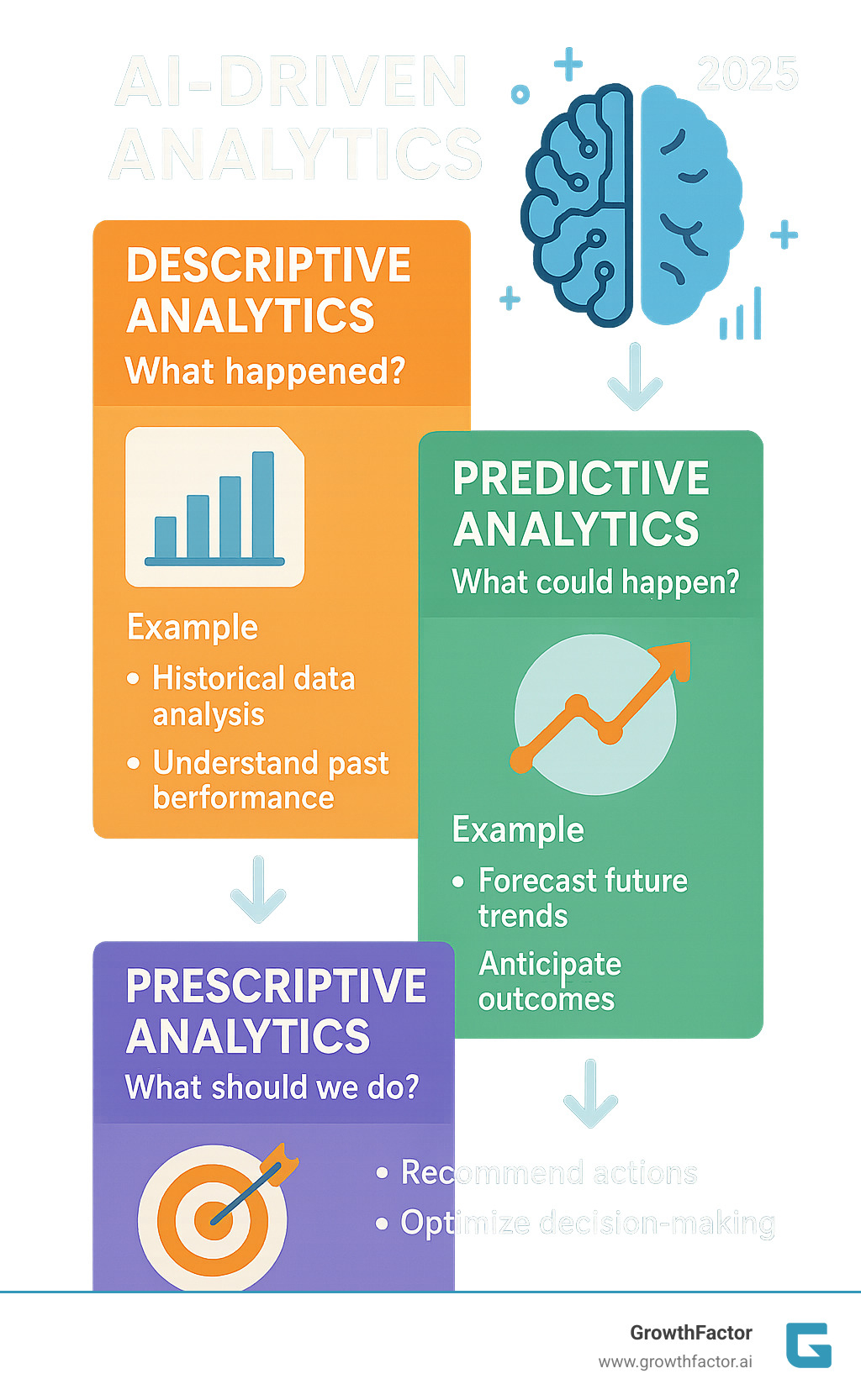Demystifying AI Analytics: How Machines Make Sense of Your Data
Written by: Clyde Christian Anderson
Introduction to the Age of AI Analytics

AI driven analytics represents the evolution from traditional business intelligence to intelligent systems that automatically find patterns, predict outcomes, and recommend actions from your data. Unlike conventional analytics that shows what happened, AI-driven systems tell you what will happen and what you should do about it.
Key Components of AI Driven Analytics:
- Machine Learning algorithms that learn from data patterns
- Predictive modeling that forecasts future trends
- Automated insights that surface hidden opportunities
- Real-time processing that analyzes data as it arrives
- Natural language interfaces that make insights accessible to everyone
The numbers tell a compelling story. The AI analytics market is projected to reach $10.9 billion by 2027, growing at a CAGR of 26.5%. Companies using AI in analytics are 50% more likely to see improved customer satisfaction, while AI-powered analytics can reduce data processing time by up to 80%.
For retail executives managing rapid expansion, this technology shift couldn't come at a better time. Traditional site selection methods - spreadsheets, gut instinct, and manual market research - simply can't keep pace with today's growth demands. Modern AI systems can evaluate hundreds of potential locations in minutes, predict revenue with 95% accuracy, and flag risks before they become costly mistakes.
Why AI Driven Analytics Matters Now:
The shift from reactive to proactive decision-making is changing how businesses operate. Instead of waiting months for quarterly reports, companies now get instant alerts about market changes, customer behavior shifts, and growth opportunities. This speed and precision directly translates to competitive advantage.
I'm Clyde Christian Anderson, Founder and CEO of GrowthFactor.ai, where we've used AI driven analytics to help retail clients open up $1.6M in cash flow and $6.5M in revenue in just seven months. My experience building AI-powered site selection platforms has shown me how the right analytics approach can transform business outcomes.

The Foundations and Benefits of AI-Driven Analytics
Navigating today's business world with traditional analytics is like using a 1995 paper map in a busy city—you see where you've been, but not what's ahead. AI driven analytics is the smart GPS that predicts traffic, suggests optimal routes in real-time, and alerts you to roadblocks. It doesn't just report on the past; it guides your next move.

What is AI-Driven Analytics and How Does It Compare to Traditional BI?
AI driven analytics marks a fundamental shift from reactive to proactive intelligence. While traditional Business Intelligence (BI) reports on past events, AI-powered systems predict future outcomes and recommend actions. The key differences are stark:
| Dimension | Traditional Analytics (Business Intelligence) | AI-Driven Analytics |
|---|---|---|
| Data Handling | Processes structured data in batches, requires manual setup for new data sources | Automatically ingests structured and unstructured data in real-time, adapts to new data types |
| Insight Type | Descriptive reports showing what happened | Predictive and prescriptive insights showing what will happen and what to do about it |
| User Interaction | Requires technical skills to create reports and dashboards | Natural language queries and automated insights accessible to everyone |
The difference is clear when considering anomaly detection. Traditional BI might show a sales drop after the month is over. AI driven analytics spots the unusual pattern as it happens, alerting you to potential problems before they become costly.
At GrowthFactor, we've seen this change firsthand. Instead of waiting weeks for site performance reports, our clients get instant alerts about market changes that could impact their expansion plans. This shift from reactive to proactive decision-making is what gives modern businesses their competitive edge.
Core Technologies and How They Drive Business Growth
The power of AI driven analytics comes from several key technologies. Machine Learning forms the foundation, allowing systems to learn from data and improve predictions over time. Natural Language Processing (NLP) lets users ask questions in plain language, while Deep Learning analyzes complex patterns, like those in satellite imagery. Predictive modeling forecasts business outcomes, such as a potential store's revenue, with high accuracy. Sentiment analysis gauges public opinion from text, and computer vision interprets visual data like foot traffic from camera feeds.
These technologies converge to deliver measurable business impact. Companies using AI driven analytics report 20% increases in revenue through better forecasting, optimized resource allocation, and faster identification of market opportunities. This frees up your team to focus on strategy instead of spreadsheets. For businesses like those we serve in retail real estate, this speed advantage can mean the difference between securing a prime location and watching a competitor snap it up.
The More info about AI for asset managers showcases how these technologies translate into real-world advantages for investment professionals navigating complex market conditions.
Real-World Applications Changing Industries
The power of AI driven analytics is clear in its real-world applications. In retail personalization, AI creates customized shopping experiences by analyzing browsing history and purchase patterns. Financial fraud detection has been revolutionized, as banks now analyze millions of transactions in real-time to spot and prevent suspicious activity. In healthcare diagnostics, AI helps doctors detect diseases earlier and more accurately by analyzing medical images.
But where we see the most exciting developments is in real estate site selection. Traditional methods involved guesswork and minimal data. More info about AI-powered retail analytics explains how modern AI systems change this entirely.
Our AI Agent Waldo exemplifies this change. Instead of manually evaluating a few locations, Waldo analyzes hundreds of sites simultaneously, considering traffic patterns, competitor proximity, economic indicators, and zoning regulations in minutes, not months.
The impact goes beyond speed. AI driven analytics uncovers hidden opportunities by identifying subtle correlations in vast datasets. It can pinpoint locations that look average on the surface but have the right conditions for exceptional performance. It's like having a scout who never gets tired and learns from every data point.
More info about AI location intelligence dives deeper into how location-based AI is revolutionizing everything from retail expansion to urban planning. For our clients, this translates to better locations, faster expansion, and reduced risk. When you can predict a location's performance with 95% accuracy, every expansion decision becomes a strategic advantage.
Implementing, Scaling, and Navigating the Future of AI Driven Analytics
Adopting AI driven analytics is less a simple upgrade and more a complete change. Success requires understanding the path of implementation, as AI touches every part of an organization—from collaboration to decision-making speed. At GrowthFactor, we've seen clients shift from evaluating one potential store location in weeks to analyzing dozens in the same period, all with greater accuracy.

A Strategic Guide to Implementing AI Analytics
A thoughtful approach is key to a successful AI implementation. Follow these strategic steps:
- Define clear business objectives. What problem are you trying to solve? Whether it's accelerating site selection or automating deal evaluation, specific goals are essential.
- Assess data readiness. AI needs clean, accessible data. Evaluate your current data landscape and identify any gaps that need to be addressed.
- Select the right technology stack. The choice is often between building a custom solution or buying a specialized platform. For industries like retail real estate, a purpose-built platform offers a faster path to value.
- Start small and scale. Tackle a single, specific challenge first, like automating site screening. Prove its value and build team confidence before expanding to other areas.
- Manage the change. Adoption hinges on trust. Ensure your team is trained, understands how the AI works, and sees early wins celebrated. This fosters natural adoption.
- Measure ROI. Track key metrics to demonstrate value. Monitor improvements in revenue, time saved on evaluations, or prediction accuracy to keep the project focused on business outcomes. You can learn more about how AI transforms property development decisions at More info about AI for property development.
Navigating Challenges and Ethical Considerations in AI Driven Analytics
Implementing AI driven analytics involves navigating key challenges and ethical considerations. Smart organizations plan for these from day one:
- Data privacy: Handling location and demographic data requires robust security and clear usage policies to protect sensitive information.
- Algorithmic bias: AI models learn from historical data. If that data reflects past inequities, the AI might perpetuate them. It's critical to actively identify and correct these biases.
- Model explainability: Stakeholders need to understand why an AI makes a certain recommendation. Black box decisions don't build trust; clear insights into the driving factors do.
- Data security: As you process more information, the investment in robust cybersecurity becomes even more critical to protect your business and your customers.
- High implementation costs: These are best viewed as an investment in competitive advantage. Early adopters often find themselves with significant advantages over slower competitors.
At GrowthFactor, we've built our platform with these considerations at the forefront. Our commitment to responsible AI isn't just good ethics—it's good business. You can learn more about our approach at GrowthFactor's approach to responsible AI.
The Future Outlook and Essential Skills for AI Driven Analytics
The future of AI driven analytics is rapidly evolving. Generative AI is already creating realistic market scenarios, while augmented analytics is making sophisticated analysis accessible to everyone in an organization. Hyperautomation is streamlining entire workflows, automating everything from initial site qualification to deal tracking, letting teams focus on strategy.
The skills landscape is evolving just as quickly. Data science fundamentals remain important, but business acumen is equally crucial to connect technology to market realities. Communication skills are needed to translate AI insights into actionable strategies, and ethical AI literacy is becoming a must-have. Above all, a mindset of continuous learning is essential to keep pace with the field's rapid evolution.
At GrowthFactor, we're not just watching these trends unfold—we're actively shaping them. Our platform evolves continuously to incorporate the latest advances in AI driven analytics, ensuring our clients stay ahead of the curve. The change to AI-powered decision making isn't just coming—it's here. The question isn't whether to adopt AI driven analytics, but how quickly you can implement it effectively. Explore how our site selection solutions can transform your real estate decisions: Find our site selection solutions.
Citations
The human algorithm
Request Your demo
Schedule meeting
Or submit your information below and we'll be in touch to schedule.


